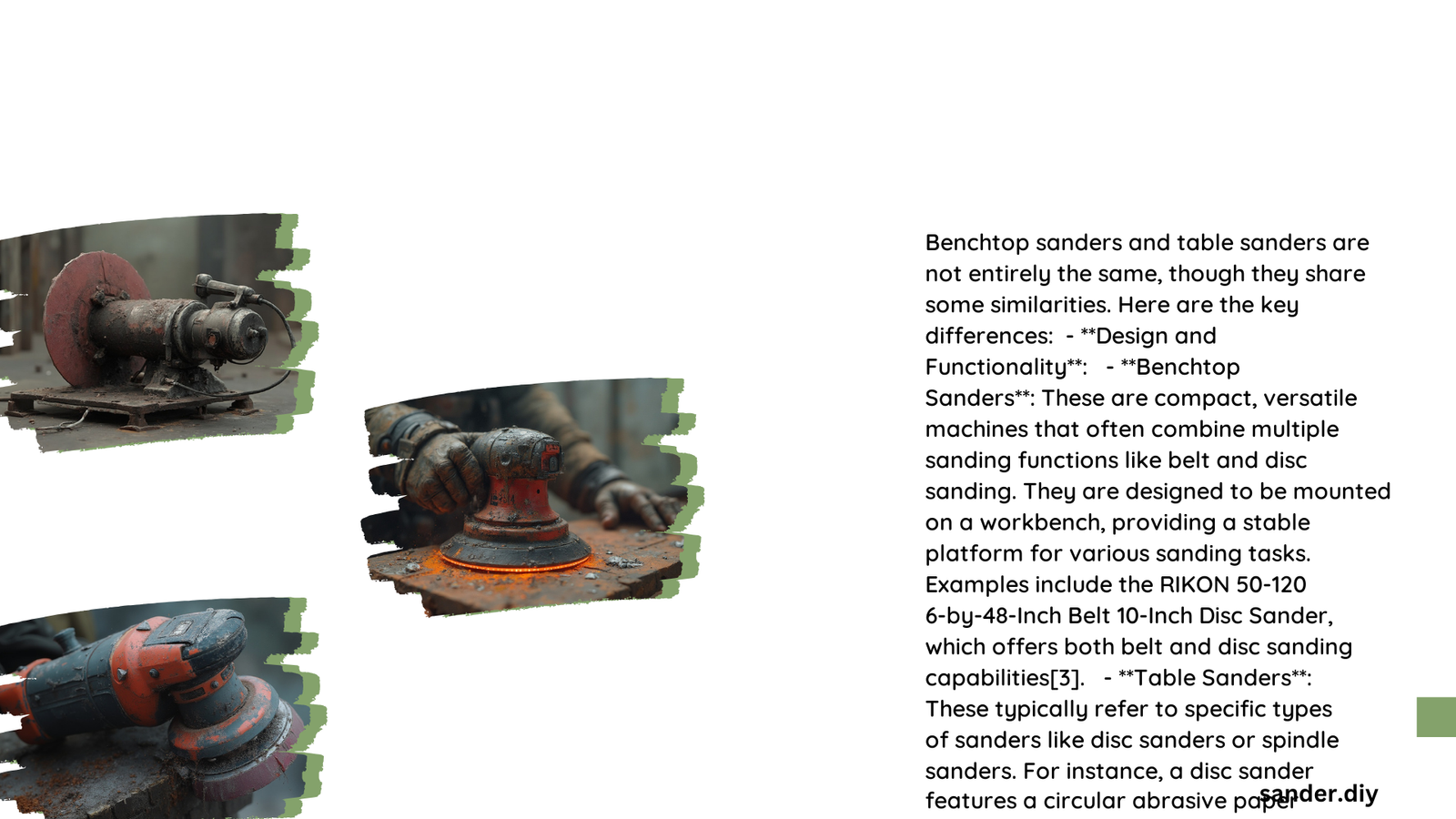Benchtop sanders and table sanders are both stationary sanding tools used in woodworking, but they have distinct differences in design, size, and functionality. Benchtop sanders are compact units designed for smaller projects and limited workspace, often combining multiple sanding functions. Table sanders, on the other hand, are larger, more specialized machines built for handling bigger workpieces and offering greater stability. While they serve similar purposes, their specific features and capabilities set them apart in terms of intended use and project scale.
What Are the Key Differences Between Benchtop and Table Sanders?
Design and Functionality
- Benchtop Sanders:
- Compact and mountable on workbenches
- Often combine belt and disc sanding functions
-
Examples: Porter Cable PCB420SA, Grizzly G1183
-
Table Sanders:
- Larger and more specialized
- May include dedicated table surfaces
- Allow for vertical, horizontal, or angled sanding
- Examples: Jet 10-20 Drum Sander, Powermatic PM2244
Intended Use Cases
- Benchtop Sanders:
- Ideal for smaller to medium-sized projects
- Precision work like edge sanding and detail work
-
Great for making Shaker boxes and small panels
-
Table Sanders:
- Suited for larger projects
- Sanding table tops, doors, and windows
- Handling thicker and wider materials
How Do Size and Power Specifications Differ?

Size Comparison
| Feature | Benchtop Sanders | Table Sanders |
|---|---|---|
| Size | Compact, easy to store | Larger, require dedicated space |
| Weight | Lighter, more portable | Heavier, less mobile |
| Example | Bucktool 4×36 belt/disc sander | Jet 10-20 Drum Sander |
Power Specifications
- Benchtop Sanders:
- Lower power ratings
- Grizzly G1183: 1 HP motor
-
Jet JSG-6: 1-1/2 HP motor
-
Table Sanders:
- Higher power ratings
- Powermatic PM2244: Robust motor with cast iron frame
What Are the Sanding Capacity Limitations?
Benchtop Sanders
- Typically limited to:
- 4\” x 36\” or 6\” x 48\” belts
- 6\” or 8\” discs
Table Sanders
- Can handle much wider and thicker materials
- Jet 10-20 Drum Sander:
- Sands material up to 500mm wide
- Handles thickness up to 75mm
How Does Portability Compare?
- Benchtop Sanders:
- More portable due to smaller size and lighter weight
-
Easier to move around the workshop
-
Table Sanders:
- Less portable due to larger size and heavier weight
- Often stationary or require significant effort to move
What Are the Specific Uses of Benchtop Sanders?
Materials and Use Cases
- Best suited for:
- Sanding smaller pieces
- Edge work
- Detailed sanding tasks
- Ideal for:
- Sanding bowl bases
- Making Shaker boxes
- Small to medium-sized projects
Limitations
- Not suitable for large projects or thick materials
- May struggle with:
- Sanding large panels
- Efficiently handling thick wood stock
What Advantages Do Table Sanders Offer?
Stability and Precision
- Greater stability due to larger and heavier design
- Crucial for sanding larger surfaces evenly and accurately
- More efficient for wide and thick materials
Cost and Performance Comparison
- Table Sanders:
- More expensive but offer advanced features
-
Powermatic PM2244:
- LED control panels
- Real-time conveyor speed information
- Sturdy frames for durability
-
Benchtop Sanders:
- More affordable options
- Bucktool 4×36 belt/disc sander
- Harbor Freight benchtop unit
- Cost-effective for smaller workshops
- May lack advanced features of larger table sanders
In conclusion, while benchtop sanders and table sanders serve similar purposes in woodworking, they are distinct tools with different capabilities and use cases. The choice between them depends on the specific needs of the project, available workspace, and budget considerations.
Reference:
1. FineWoodworking: Tool Test – Belt Sanders for Woodworkers
2. Axminster Tools: Which Sander Is Right For Me?
3. Sawmill Creek: Recommendation for a Table Top Belt/Disc Sander
